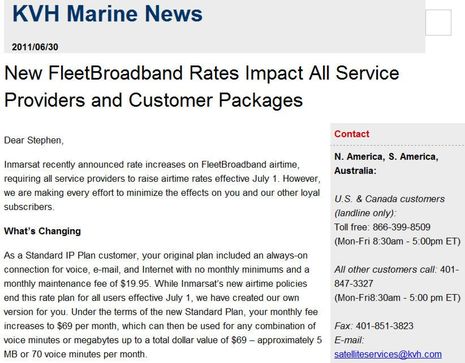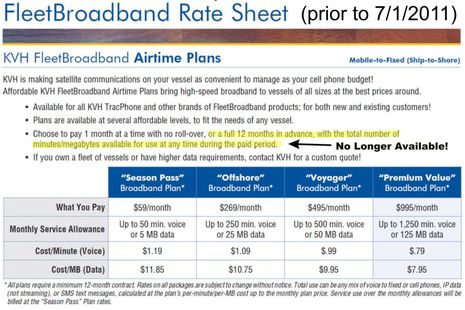Inmarsat FleetBroadband airtime changes, bad news for the little guys?

It seems that on July 1 Inmarsat rather harshly changed the game for boaters who have a Fleet Broadband system but only use its data and/or voice services occasionally. I emphasize "seems" because the intricacies of satellite airtime rates are daunting. That's largely because Inmarsat wholesales airtime to distribution partners like Stratos and Vizada who then resell it to service providers like KVH, the SatPhoneStore, and many others who finally package it up in innumerable ways for the masses. It's hard to figure out what's going on, let alone who's responsible...
So let's start with known facts. In late June, as shown in the screen shot above, KVH notified customers that Inmarsat "rate increases" required all service providers to raise airtime rates effective July 1. Specifically, those subscribed to the minimum $20/month maintenance plan (with pay-as-you-go service at about $1.50 a minute and $13.75 a megabyte) would be switched to a "Standard" $69/month plan that includes $69 worth of data or voice at somewhat lower minute/megabyte rates. Which might be fine if you're cruising much of the year, but not so much if your boat is hauled out. Another shock for folks who only use their Fleet Broadband hardware irregularly was the end of the policy that let you consume a whole year's worth of monthly plan data and voice whenever you wanted if you prepaid the entire year.
The marine electronics dealer/installer who first told me about this situation feels that "this will completely orphan the recreational community" and he included an email from a customer who had already cancelled his service. But when I contacted Inmarsat to ask about the changes, they professed surprise at KVH's statement and claimed that in fact they'd lowered wholesale airtime prices to their distributors. Argh! And actually if you look at the other plans KVH introduced on July 1 versus the old plans shown below, you'll see that the "implied rates" for the included minutes and megs are inexpensive compared to the past (but watch out for those increased "out of plan" data charges).
So perhaps KVH should have phrased it "rate policy changes" instead of "increases" but I'm not sure that will make much difference to folks paying the bills. But then there's the question of whether Inmarsat itself changed the policies, or Stratos (who distributes airtime to KVH), or even KVH itself (which, mind you, also somewhat competes against Fleet Broadband with its mini-VSAT service). I'm not positive, but I think Inmarsat itself precipitated these changes, largely because of service provider news found on this Stratos page (and, mind you, Stratos is owned by Inmarsat...oh, the complications). I've also heard that other service providers have changed their airtime rates like KVH did, though I can find no evidence of that on the Web. Interested readers may be able to help with that research, and if someone finds an occaisional-user-friendly FB plan, they will be much appreciated.
But if Inmarsat did change its policies so that existing small time users are suddenly looking at much larger annual airtime bills regardless of their actual usage, I think the company should reconsider. I realize that such users may not loom large on Inmarsat's radar -- as so many of their end users are large vessels with large budgets -- but I do think they have a certain moral obligation here. After all, even the latest little FB150 terminal built to their specifications starts at about $5,000. The angry dealer/installer may well have a point:
I also think it is outrageous that Inmarsat is able to so significantly impact the cost of using a very expensive piece of hardware. The $12k domes people have will not be practical to operate and in the mean time, us dealers look like asses for selling it to them!
There may be more to this story than I've yet uncovered, but I trust that we can get to the bottom of it together. For instance, I know that Gram Schweikert, FB150 and OpenPort tester extraordinaire, is also investigating (between boat projects in NZ and a delivery to Vanautu). In fact, he recently wrote an expert and careful comparison of bluewater communications options and costs that's already gone to press for the September issue of Cruising World. An online addendum here and at CW is probably going to be necessary!


 Share
Share
Looks like they may have hired a CFO from the cellphone data services industry.